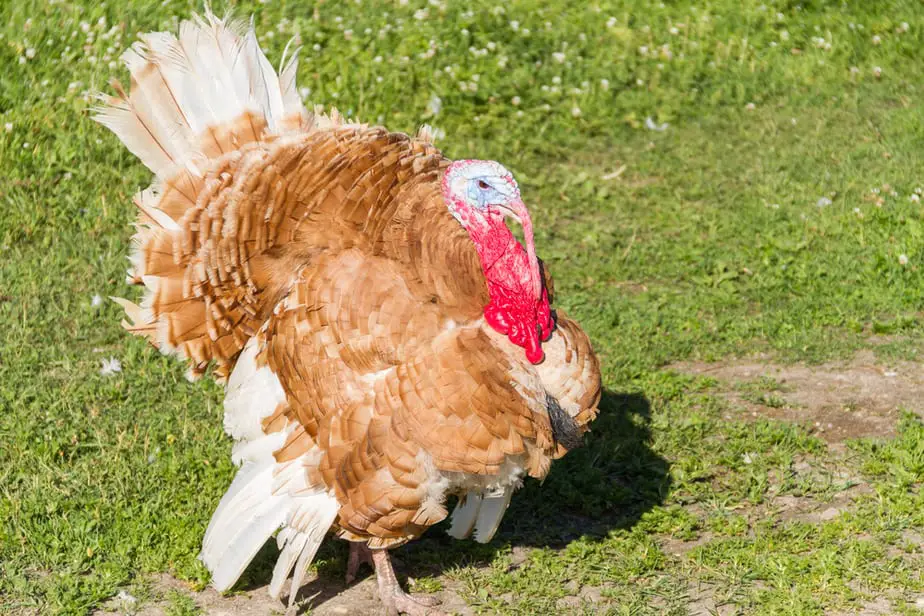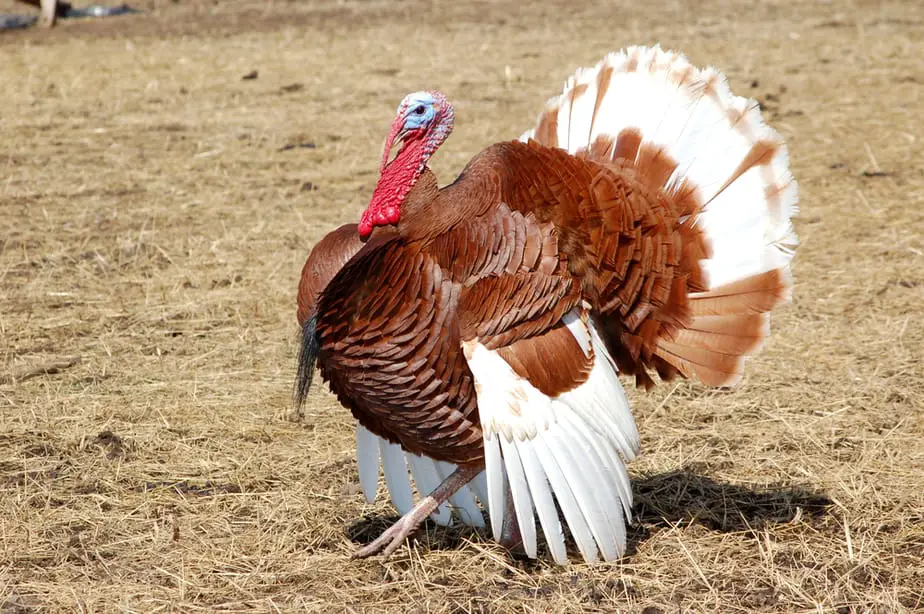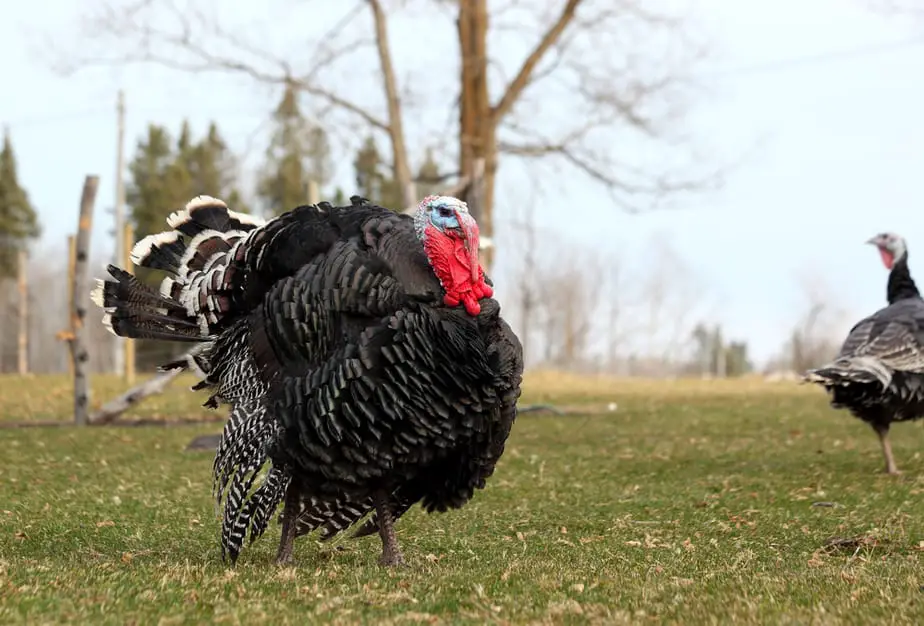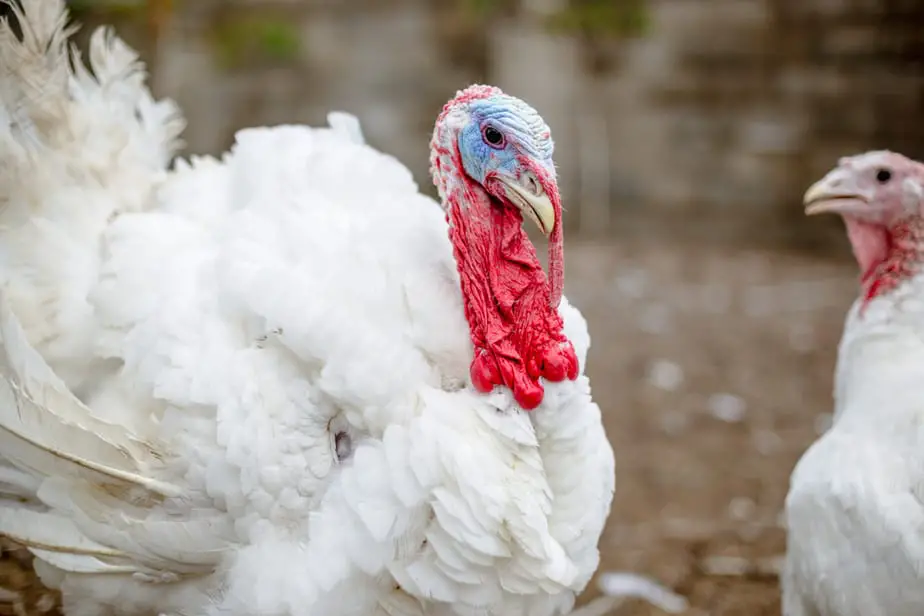The first step to learning how to raise turkeys in your backyard is realizing that turkey-rearing is usually for the meat rather than the eggs (like when you raise chickens). Turkey meat is chock full of protein, healthy fats, and other essential nutrients that keep our bodies healthy — and they’re large birds — which means you get nutritious meat and more of it compared to those who opted to raise other poultry.

In this article, we’ll be providing you with everything you need to know to successfully raise turkeys in your backyard. Overall, raising your own meat is a worthwhile venture, so stick around to see how you can make the most of it!
Table of Contents
1. Know Your Livestock Laws
Technically, turkeys are farm animals — and farm animals aren’t always a welcomed sight, depending on where you live. For instance, if you live within city limits, there may be a restriction on the number of turkeys you can have on your property… or you may not be able to have them at all. Before you throw your dollar away on a huge turkey family, check up on your local laws and regulations to see if you can raise livestock on your property.
After all, it’s better to be safe than sorry. You may find this page helpful concerning poultry laws within city limits. We recommend to check and see if your area is listed and what the laws are.
2. Prepare Enough Roaming Space
As with any livestock animal, turkeys require an adequate amount of space to roam in order to maintain their health. If you pack too many turkeys into one small area, you could end up with a whole host of problems ranging from territorialism and food competition to unsanitary conditions extremely quick.
Like chickens and other poultry, turkeys should be given a grassy patch of land, preferably a third to half of an acre if you plan to raise 10 or more turkeys. Remember, they’re big birds and cover a lot of ground daily. Plus, they like to supplement their diets with bugs found in the fields — we highly recommend free-ranging your turkeys (the more nutrients they get, the more nutrients your family gets!).
3. Shelter for Your Backyard Turkeys
It’s no secret that turkeys are prey to predatory animals like coyotes and bobcats, and their eggs can fall into the greedy little clutches of raccoons, snakes, and foxes. Providing shelter for your turkeys is essential to keep them protected when you’re not on watch. And it’s not only the predators and thieves you have to worry about — but the natural elements, as well.
The best shelter for Turkeys is inside a completely sealed building, preferably with concrete floors that are easily cleaned. Each turkey should have about 6 square feet of indoor space. This type of shelter situation will prevent any predators from being able to enter and will also make it easier for you to manipulate temperatures based on the season to keep the turkeys comfortable.
Alternatively, a spare room in an already existing barn or other sealed outdoor building is suitable, as well.
Brooder Area for Raising Poults
Raising turkeys from poults requires a setup that’s a little different than a shelter for adults. You’ll need to have a brooder available to keep the baby turkeys warm, contained in a manageable area, and not exposed to the outdoor elements (and predators). There isn’t necessarily a required build for a brooder, and you can easily improvise a space.
Basically, you’ll need an enclosed area that gives each poult two square feet of space, is well ventilated, and at least a foot high so that nosy dogs can’t look in, and baby turkeys can’t hop out. You can make this enclosure out of three sheets of plywood and a screen in front for airflow. You can also utilize a large fish tank if you don’t feel like putting your craftsmanship to the test.
Be sure to put pine shavings in the bottom of the brooder. Some opt for sand rather than wood shavings, as sand is easy to clean and keeps the enclosure dry. You can also add a couple of inches of pine shavings atop the sand in a corner to provide a comfortable area for the poults to sleep.
Place a 250-watt infrared heat lamp in one corner of the brooder along with a thermometer to monitor the temperature. Your brooder should be kept between 95 and 98 degrees Fahrenheit. Keep an eye on the behavior of the poults and adjust the location of the lamp if need be. Poults will huddle underneath the heat if they’re cold and avoid the lamp if they’re too hot. If they’re too hot, consider placing the lamp higher up. Know the outdoor temperature, as well. If it’s hot enough to bring the indoor temperature to the 90s, shut the lamp off. If it’s cold, keep the lamp on.
Lastly, place a feeder and waterer in the brooder that is designed for poults. These are specially designed to prevent the poults from soiling their water or food source.
Our Favorite Heating Bulb:
- 250 Watt/120 Volt Near Infrared Red Light Bulb
- Near Infrared, NIR-A, Red Light
- RoHS Compliant Certified Product - CE Certified
- This Bulb Fits Standard US Socket E26 Rated 250 watts - 110 - 120 Volt / 100 - 130 Volt Electrical Systems - USA, Canada, Mexico, Japan
Last update on 2025-03-28 / Affiliate links / Images from Amazon Product Advertising API
Our Favorite Feeder and Waterer Set:
- RentACoop Has a Solution! |1L Chick Feeder & 1.5L Chick Drinker Set with New Adjustable Stands. Provide fresh, clean water and food for your growing flock from day old chicks through adult chickens. Also suitable for ducklings, turkey poults, quail and quail chicks, other poultry and small birds
- We Thought of Everything! - ALL NEW Adjustable Stands accommodate growing chicks and keep your RentACoop drinker and feeder off the floor of your brooder for less mess! Easy to assemble and clean as needed. Fill with chick starter, chick grower feed, fresh water daily, for up to 6 chicks
- Why You'll Love It! - Sturdy, premium quality BPA-free plastic chick water bottle and chick feeder are made to last. Efficient, low maintenance, gravity fed design leaves more time for bonding and enjoying your baby chicks!
- What’s in the Box? - One (1) 1L (2.2lb.) Chick Feeder; One (1) 1.5L (50oz.) Drinker; Two (2) Adjustable Stands (from 1-6" H); Instructions
- You Might Also Like - RentACoop Little Red Barn Chick Brooder; RentACoop 10x10 Heating Plate; RentACoop 12x12 Heating Plate; RentACoop Big Red Barn Chick Brooder
Last update on 2025-03-28 / Affiliate links / Images from Amazon Product Advertising API
Bedding
As bedding, you should use pine (NOT cedar, which is toxic to poultry) wood shavings as an alternative to sawdust or newspapers (or any other makeshift litter). Poults may consume the sawdust and neglect eating their pellets, resulting in starvation. Newspapers may cause slipping and injury in both young and adult turkeys so it’s best to avoid using this material.
Our favorite bedding for turkeys is Fresh Flakes Pine Shavings. It contains all-natural, compostable pine wood shavings, it gives off little dust when spread on the floor, they’re incredibly absorbent to make messes more manageable, and the shavings were heat dried to prevent future mold spores.
Though Pine Shavings are healthier for turkeys and poults, you should still ensure that the shelter for your livestock is well ventilated.
You can likely find it at your local farm supply store or purchase it online through Amazon:
- All-natural & compostable pine shavings for coop bedding
- Low dust
- Ultra-absorbent low moisture shavings
Last update on 2025-03-28 / Affiliate links / Images from Amazon Product Advertising API
4. Fencing
When it comes to raising turkeys, the higher the fence, the better. These birds can and will make an effort to fly up and over the fence like their lives depend on it (which, they probably do but that’s beside the point)… which is why your fencing should be at least 4 to 6 feet high to prevent escape.
We recommend that you build a fence made of chicken wire and wooden posts and frames. When it comes to the fence posts, it’s a good idea to cure them in concrete as an added measure of security. You might also want to consider burying the fencing at least 2 feet under the ground to deter burrowing predators from digging under the fence.
Be sure that you clip or smooth down any jagged edges to ensure your fence doesn’t pose a threat to your livestock.
Our Favorite Poultry Fencing:
- Half inch hardware cloth, ideal for snake fence, chicken wire, opossum rehab cages,chicken coops run,rabbit fencing, flower beds, wide gutters guard, fruit trees, vegetable garden, to keep out small critters such as voles, gophors, racoons,etc
- The holes are only 1/2 inch to keep critters out and the chickens / rabbit safe, protect your garden fruits and vegetables from rodent animals. The 1/2 inch openings would have to be really small to get through. In the area of Wisconsion, Colorado, Cal kings, small baby copperhead snakes and rattle snakes come for damage seasonally. Dig a shallow trench before installing to ensure the fence is partially underground for peace of mind
- It's galvanized and very rust proof. Galvanizing after welding to ensure that all welding points are galvanized for maximum rust resistance and long life. Wider weave not too stiff, the material will confirm to rolled shape as tree guards for fruit trees, 19 gauge easy to lay down and easy to cut with wire cutter/scissors. Keep gophers out of vegetable garden
- Use this to protect vegetables and flower roots, bulbs, rhizomes, etc from tunneling animals. It can be used to make individual baskets or line raised garden beds
- Use this material to line the bottom of your chain link fence and cut it in half by leaving it in a roll with a hack saw; it is plenty stiff for what you want to use it for. This mesh solved issues with snakes, gophor, skunk, chipmunks, rabbits and other creature pests living under your wooden deck
Last update on 2025-03-28 / Affiliate links / Images from Amazon Product Advertising API
6. Choosing Which Turkey is Right for You
When it comes to learning how to raise turkeys in your backyard, it can be confusing trying to choose the perfect turkey breed for your specific needs. In this section, we’ll be looking over the different breeds most commonly used for meat to give you a better idea of which is best for you.
Bourbon Reds

Originally bred in Bourbon County, Kentucky in the 1800s, the Bourbon Reds are considered one of the best tasting turkeys of the heritage breeds available. They can reach a decent size, with the toms growing up to 23 pounds and the hens up to 12 pounds.
These turkeys are our favorite due to their delicious flavor and size (though they’re not as large as the Bronze or Holland turkeys), making them great as meat animals.
Standard Bronze

The most common breed in America throughout history, the Standard Bronze turkey is one of the biggest breeds of heritage turkey breeds. These are great birds that will provide a lot of meat, thanks to their broad breasts. Males can get up to 25 pounds and females up to 16 pounds.
Standard Bronze turkeys can still naturally mate, unlike their relatives, the Broad-Breasted White turkey, which is a plus for those who are new to farming or just don’t want to deal with the work of artificial insemination.
Broad-Breasted Whites

Broad-Breasted Whites are the most commonly available turkey for meat. Though they are good for lots of meat due to their size and selective breeding, they can be a hassle as they require artificial insemination. They are also more prone to disease and joint issues, which is also due to selective breeding that allowed these turkeys to grow to maturity quicker (and, thus, give less time for complete bone development).
These are probably the last kind of turkey we would recommend you raise, however, they are widely available and more affordable than others may be which may be what you’re looking for.
The Benefits of Raising Turkeys in Your Backyard
Though there are a few downsides to raising turkeys in your yard (which we’ll cover in the following section), there are also a lot of benefits to having your own homegrown meat. Let’s go over the pros of rearing turkeys:
- You know exactly where your meat comes from. Unlike commercial meat, when you raise your own turkeys you know what they’re fed, how they’re kept, and how they’re butchered… which means cleaner food for you and your family.
- They’re cleaner than other poultry. Unlike chickens, turkeys are relatively neat and won’t toss soiled bedding all over the place (including into their water or food) and when you feed turkeys, their food won’t get scattered all over the place.
- They eat bugs on your property. Don’t like the idea of creepy crawlies being on your lawn? Not to worry! Turkeys have you covered. These feathery friends love to roam their enclosures and supplement their diets with juicy bugs.
- They’re a great learning opportunity. If you’re wanting to share a new experience with your family or learn more about homesteading or rearing livestock in general, raising turkeys is a great way to go about it.
The Cons of Raising Turkeys in Your Yard
Now that we’ve looked at the benefits of raising turkeys, let’s take a look at the downsides:
- They’re kind of stupid. It’s no surprise that most birds are a little dumb, and this is especially so with turkeys. They’re curious, but to the point that they find themselves injured or even dead. That’s why it’s imperative that you build high fences and keep barrels of water away from their enclosure (as they’re prone to flying into things and drowning) and securely put them up at night.
- You may have to mother a few poults. If you plan on breeding your turkeys for a meat supply that can replenish itself, be aware that some turkey moms may not be the best and could possibly abandon their babies even when they still need care. In cases like this, you may have to step in — and that can be a lot of work. Keep an eye on new mothers and babies and separate them from the rest of the flock for the first month or so.
Final Thoughts
Overall, raising turkeys can be a rewarding experience for those who are looking to be self-sufficient or for those who just like trying something new. With a decent setup, rearing your poultry shouldn’t be too difficult. Remember that shelter needs vary a little between poults and grown turkeys and avoid too low of fences, deep water, or sharp edges in or around your turkey enclosure.
Happy farming!



